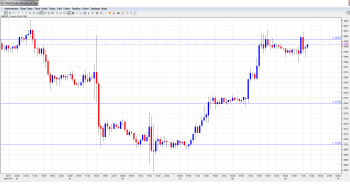EUR/USD is steady on Wednesday, as the pair trades just below the 1.38 line in the European session. The euro is looking sharp, having gained close to 100 points so far this week. In economic news, German Trade Balance surprised the markets, sliding to a six-month low. In the US, today’s highlight is the minutes from the Federal Reserve’s last policy meeting. We could see a reaction from the markets following the Fed release.
Here is a quick update on the technical situation, indicators, and market sentiment that moves euro/dollar.
EUR/USD Technical
- EUR/USD was stable in the Asian session, trading close to 1.3790. In European trading, the pair crossed above the 1.38 line before retracting.
Current range: 1.3740 to 1.38.
Further levels in both directions:
- Below: 1.3740, 1.37, 1.3650 and 1.3560, 1.3515 and 13450.
- Above: 1.38, 1.3830, 1.3895, 1.3940, and 1.40.
- 1.3740 continues to provide support.
- On the upside, 1.38 is under strong pressure. 1.3830 follows.
EUR/USD Fundamentals
- 6:00 German Trade Balance. Exp. 18.0B, actual 15.7B.
- 14:00 US Wholesale Inventories. Exp. 0.5%.
- 14:30 US Crude Oil Inventories. Exp. 1.0M.
- 17:01 US 10-year Bond Auction.
- 18:00 US FOMC Meeting Minutes.
- 11:30 US FOMC Member Daniel Tarullo Speaks.
*All times are GMT For more events and lines, see the Euro to dollar forecast.
EUR/USD Sentiment
- Markets eye Fed minutes: The Federal Reserve will be in the spotlight on Wednesday, as the Fed releases the minutes of its March policy meeting. Last week, Fed chair Janet Yellen said that inflation and employment levels needed to improve considerably. So it shouldn’t be a surprise if the minutes state that the US still has a long way to go on the road to recovery. If the minutes don’t sound upbeat about the economy, the dollar could lose some ground. Currently, the Fed is purchasing $55 billion in assets each month under its QE scheme. There have been three tapers to QE so far, and Yellen plans to wind up the program in the fall, provided that the US economy does not run into any serious turbulence. At the same time, the Federal Reserve has stated that it has no plans to raise interest rates until sometime in 2015. The taper pace and the rate hike pace depend a lot on jobs data.
- German trade balance slips: Germany’s trade surplus narrowed in March, dropping to EUR15.7 billion, its smallest surplus since July. The weak reading ended a string of solid German releases last week, as Retail Sales, Unemployment Change and Factory Orders all beat their estimates. As Germany is the Eurozone’s largest economy, the euro is sensitive to German data, and recent positive data has help the euro trade at high levels.
- Ukraine crisis worsens: Tensions between the US and Russia continue to heat up over the Ukraine. On Monday, pro-Russian demonstrators took over a government building in an industrial city in the east of the country and declared their independence. Russia has warned the Ukraine not to react with force, while the US has accused Russia of continuing to foment unrest in the Ukraine ahead of elections in May.
- ECB says all non-conventional options available if needed: While the ECB did not make any policy changes last week, the accompanying statement and press conference by Draghi were dovish: QE and a negative rate are on the table. On Tuesday, ECB policymaker Yves Mersch said that ECB officials were working on a QE scheme in order to combat deflationary pressures, but added that there was no immediate need for such a program. Meanwhile, Bundesbank President Jens Weidmann said that monetary policy alone will not solve the Eurozone’s economic problems, and called on political leaders to implement fiscal and other reforms.
- NFP climbs but misses expectations: US Nonfarm Payrolls, one of the most important economic indicators, rose nicely last in March, climbing to 192 thousand, compared to 175 thousand a month earlier. However, the markets were looking for more, with the estimate standing at 199 thousand. The Unemployment Rate also missed the mark, as it edged up to 6.7%. The estimate stood at 6.6%. On Tuesday, JOLTS Job Openings looked strong, climbing to 4.17 million, well above the estimate of 3.99 million. This was the key employment indicator’s best showing in over six years.

